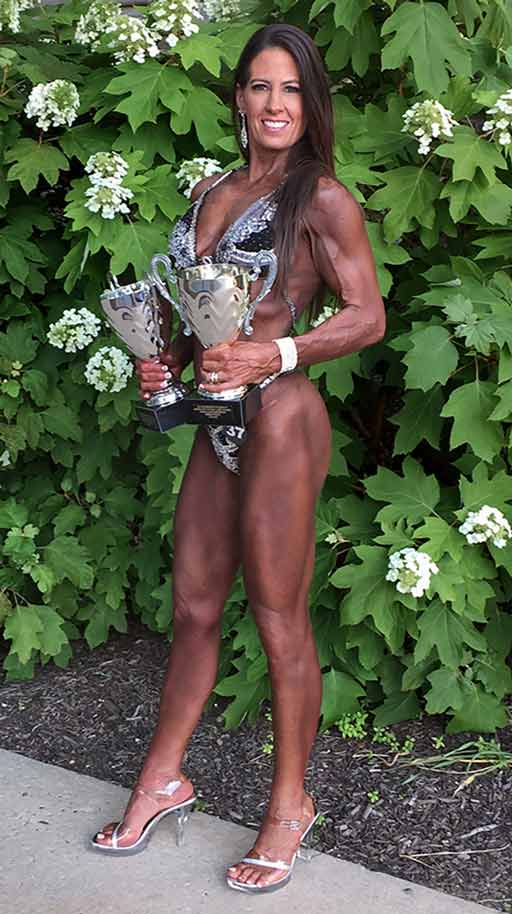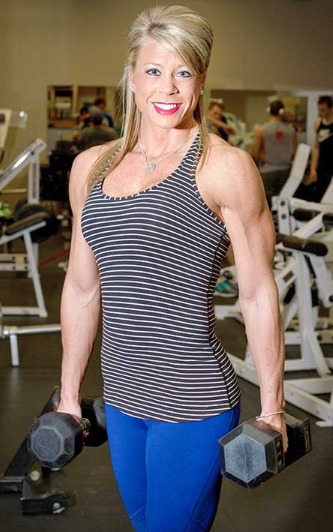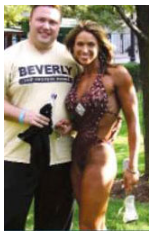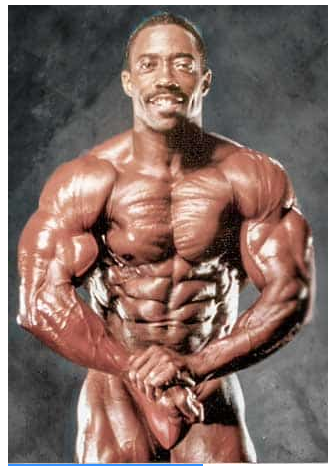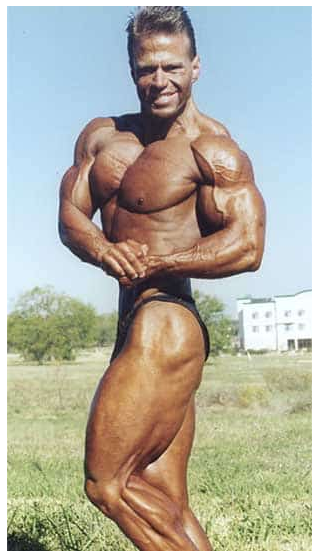Old School Muscle Building Program for Your Legs, Arms, and Upper Body
No Nonsense Magazine Vol 14, #1
By: Roger Riedinger
- Is This Program For You?
- 1. Experience level at least one year of consistent training; will work best for experienced bodybuilder that needs a change of pace.
- 2. Goal – gain muscular size and strength
- 3. Frequency – train on three alternate days a week for 75-90 minutes.
- 4. Length of program – six weeks
- 5. Recommended supplements – Ultimate Muscle Protein or Mass Maker and Up-Lift
I wrote about an old school advanced arm building program in the last No Nonsense Magazine (vol 13, #4).
In this issue I’m going to continue with the same theme. This routine is not for the beginner. It’s designed for those who are well established and experienced in bodybuilding, have still not gained the muscular size they desire, and are ready to try something new (well, actually something old). If your progress has been slow lately, I’m certain this routine will help you. I’ll bet it’s different than anything you’ve seen or ever thought about. That’s doesn’t matter if you start growing, does it?
Back in the day, it was always recommended that you take a complete week off from lifting before embarking on a new routine. That’s still a good idea so let’s take a week off and then start fresh next Monday.
Workout Part 1 Legs Arms

Squats will be your only leg exercise for the next six weeks. Old school or new school squats are the premier exercise for acquiring growth and power. But you must train them hard and religiously.
Arms
After your squats are completed take a 5-10 minute break, then hit arms. Old school arm training means heavy weight, lots of sets, and lower reps than you might be used to. Select three bicep exercises and three tricep exercises. For example: EZ Bar Curl, Incline DB Curl, and Concentration Curl, Pullover and Press, seated EZ Curl Bar Extensions, and Tricep Pushdowns. You don’t have to pick these exact exercises, choose your own, but once you pick your exercises stay with the same ones for the entire six weeks.
Now, you are going to warm-up a little, then pile on the weight and do five repetitions of the first tricep exercise, let’s say the Pullover and Press; when you complete your set walk slowly over to the EZ Curl bar and complete a set of curls for five reps. Then rest for just about one minute. Repeat this until you complete 4 or 5 sets for each exercise. Your reps are low, so the weight must be heavy and you’ll have to do multiple sets to really stimulate growth.
Set up the weights for your next tricep exercise and bicep exercise and follow through in the same manner as before until you complete another 4 or 5 sets each. Then complete the remaining two exercises in the same way.
This is a type of training that you are probably unfamiliar with because it has gone out of vogue, not because it was ineffective, but it was hard work and only a limited number of trainees can stick with it for the entire six weeks. Muscle magazines became very popular just about the time these workouts were producing great results. But the magazines couldn’t promote this type of training, they had to find something more glamorous to promote, even if it was less effective. Thus, one of the most effective training systems in the history of weightlifting became extinct. Well, that’s not going to keep us from getting the gains in size and strength we’re after, is it? Let’s move on to part 2.
Workout Part 2
Some bodybuilders of the past did both parts of the workout on one day. They trained two or three days per week and did the entire workout Parts 1 and 2 on each of those days.

EZ-Bar preacher curl bench with moderate grip. Accentuating negative (slow down movement) will focus more on the biceps with a relaxed grip. To focus on forearms (Brachioradialis) tightening and reverse the grip elbows firm against the preacher bench. While attempting to complete each rep, you feel the need to rise out of the seated position reduce the weight. Continue the strict prayer seated position.
Legs and Upper body
A more suitable alternative, while staying within the old school system of three workouts per week (usually on Monday, Wednesday, and Friday evenings), is to alternate the two parts. One week Monday and Friday will be squats and arms, Wednesday will be squats and upper body. The next week Monday and Friday will be squats and upper body with Wednesday squats and arms. And yes, you’ll do squats on every workout day.
Start with the same squat workout that you did in the previous workout. The reason we start with squats is simply because by the time you have completed your upper body work you will be too tired to do justice to such an essential exercise as the squat. Use the same weights for your squats each workout for a week, then add 10 lbs to the bar the next week for each set.
You can choose your own exercises for upper body, but as a suggestion only, alternate Bench Press and Chins or Pulldowns for your first series. Perform them just like you did the arm exercises, 5 reps on the bench press, walk slowly to the lat machine and perform 5 heavy reps, then rest for about one minute and repeat until 5 sets of each have been performed. Your next two exercises might be High Incline Presses to hit both upper chest and shoulders and Bentover Rows.
Nutrition
This workout program is hard and heavy. It will produce great results but you must work it from three standpoints † exercise, nutrition, and rest. We’ve covered the exercise portion † now for the diet. To gain size and strength you are going to have to eat a lot of nutrient rich food. If you are already are eating a lot, you’ll have to eat more. That’s how you gain.Be sure to include plenty of protein, vegetables or salads, and complex carbohydrates with every meal. A protein supplement is invaluable. Ultimate Muscle Protein, Muscle Provider, or Mass Maker will provide the highest form of protein available. If you like milk, mix your protein shakes with milk instead of water during this bulking phase. Add peanut butter or nut butter to your shake and eat nuts throughout the day. Nuts contain extra protein and healthy fats. The extra calories combined with these heavy workouts will result in superior muscle gains.
Rest as much as possible. Make an all-out effort to sleep at least 8 hours per night. More is better. If you can, relax a little more during the day. (I know, easier said than done, but at least make the effort.)
This is a rigorous workout and it is common to run short of energy. Up-Lift will work wonders for you. Take 2 scoops in cold water about 10 minutes before you start training, then another scoop or even 2 scoops when you complete the squat section. It is really important that you squat each workout day, and the addition of Up-Lift will allow you to continue to train hard and heavy sets on every one of the remaining exercises. Train at night? Don’t worry Up-Lift won’t keep you up. You’ll only be training 3 days a week, so two containers of Up-Lift should take you through the entire six week program.
As I mentioned at the start, this is not a course for beginners to follow; only the bodybuilder with some experience should attempt this schedule. However, if you qualify, train hard and religiously, fuel your body with plenty of food and Beverly protein supplements, rest as much as possible, and give this routine a dedicated six weeks, it is a sure fire muscle building plan to improve your size and strength.
SURE FIRE SIZE AND STRENGTH TRAINING PROGRAM
- Training Days: M-W-F
- Monday: Part 1
- 1. Squats: 9 x 5, 4, 3, 2, 1, 2, 3, 4, 5 reps
- 2. Triceps Pullover and Press 4-5x5
- 3. EZ Bar Curl 4-5x5
- 4. Seated EZ Curl Triceps Extension 4-5x5
- 5. Incline DB Curl 4-5x5
- 6. Tricep Pushdowns 4-5x5
- 7. Concentration Curl 4-5x5
- Wednesday: Part 2
- 1. Squats: 9 x 5, 4, 3, 2, 1, 2, 3, 4, 5 reps
- 2. Bench Press: 5x5
- 3. Lat Pulldown: 5x5
- 4. High Incline Press: 5x5
- 5. Bentover Row: 5x5
- - repeat Part 1
- Then start the following Monday with Part 2.


